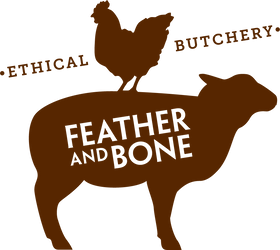Plate to Paddock - consumers as change agents
Last week in these pages we raved on about the beastly beauty of the whole carcasses hanging in our cool room. As well as the visual aesthetics, what moves us is the way these strong, healthy carcasses embody the beauty of the regenerative farming practices that produced them. Read the Beastly Beauty blog.
This week we're still on about carcasses but this time we're focussing on the abattoirs that handle these beautiful carcasses.
Two interesting newsletters came across our desk this week which, on the heels of our fruity rhapsodising about the beautiful carcasses, made us think about slaughter.
The first was an article from The Sustainable Food Trust (SFT) about a new report that finds that the UK's network of small, local abattoirs is near collapse. 'At a time when demand for local food is on the rise, and issues of welfare and sustainability are at the forefront of many consumers’ minds, the loss of more than a third of small abattoirs over the last decade alone is jeopardising the future of sustainable, local food systems.'
The second was a newsletter from Western Daughters, a wonderful whole animal butchery in Denver, Colorado which appears to operate very much like us. This newsletter told a very familiar tale about a small-scale poultry farmer who had been forced to suspend production due to the ongoing struggle with processing problems. Did you know that 'there is only one poultry processing facility in the state of Colorado that does birds from outside producers (not their in-house brand) and they require a minimum of 1000 birds'? (If you did know that, email me and I'll give you a free pack of sausages.)
You don't need me to tell you that small, pastured farmers don't process 1,000 birds at a time, so that ruled out this farmer. Eventually, the farmer set up a mobile abattoir across the Colorado border in Kansas and drove the birds back and forth across the border, but this proved unsustainable and they finally quit.
There are lots of interesting things about these two articles.
Despite many differences in population and geography, it's clear that our UK and US cousins working in the 'sustainable' meat industry are facing very similar issues to those we deal with here. But they also appear to be struggling with the problem of how to encourage consumers to understand their agency in the food chain and to see that the meat on their plate is the tip of the iceberg. Marketers have taught consumers to value the term 'paddock to plate' but no one's demanding that consumers take responsibility for their role in the value chain going in the other direction. It's time to start talking about 'plate to paddock' and the role of the consumer in everything to do with food - including the bits no one talks about. Like slaughter.
Over the last seven years we've written a lot about abattoirs and 'processing' (the euphemism generally used for animal slaughter) from many angles. Usually we're writing in response to the regular expressions of concern about this topic from our customers or the distressing exposure of errant practice at an abattoir. A brief excursion into the vault reveals that we haven't actually ranted about abattoirs for ages which I take to be a good sign. That is, no heinous abattoir infractions have been publicised recently so the outrage that greeted the wave of problems about four years ago must have had some impact.
Certainly, the introduction of CCTV cameras into many abattoirs improved things significantly. In our view, the meat processing industry remains troublingly opaque despite the stringent regulations and high standards we have here. We'd love to see the industry embrace a more open relationship with everyone from farmers to distributors through to consumers. We try to offer transparency at every point in the process and we don't see why we - all of us - shouldn't expect the same from abattoirs. But things here are certainly better than in many other places.
However, from the small-scale, pastured producers' perspective, processing can still be very difficult.
Our system is increasingly geared toward producing the most meat for the least cost in the fastest time and distributing it to a market that rewards speed and volume over notions like 'quality'. The first casualty in this system is animal welfare, the second is environmental welfare and the third is human health as we begin to understand the impacts of digesting all the chemicals required to maintain intensive mono-production systems. We haven’t really even begun to understand the full cost of these casualties to our collective welfare and consequently the price of industrially-farmed food remains artificially low.
The fourth casualty is the rather nebulous idea of our humanity. A model of farming animals inside sheds for human consumption is an ethically contentious one to start with and it's not hard to see how a system that encourages and rewards heartlessness can easily be abused at any point in the process. (And then there's the idea of the potentially corrosive impact that this system might be having on our collective emotional and spiritual welfare. Should probably stop there?)
In this rush to growth for growth's sake, abattoirs are no exception. Where once there were lots of small or medium-sized operations catering to local producers, there are now fewer, large abattoirs dedicated to high-volume export markets. The dramatic consolidation of the meat processing industry over the last 50 years has hit small producers hardest - fewer facilities, further apart and less negotiating power.
In some instances the quality is poor but, with no viable option within an acceptable distance, the farmer is forced to cop it. One of the poultry farmers with whom we work is in this position. They drive their birds to the processing facility, wait until they're ready and then drive them back to the farm where they dry the birds overnight and carefully pack them so that they can deliver a product that is finished and packed as carefully and professionally as it was grown. A product they feel as proud of and care about as much dead as they did when it was alive. There are many other similar stories.
In response to the situation, a growing number of resourceful, small-scale producers who are determined to free themselves of their reliance on abattoirs are slowly working through the tortuous process of negotiating financing and licensing issues to set up on-farm abattoirs. Each time one succeeds, they provide a precedent for the next. (We're looking forward to telling you one of these stories very soon, in fact.) There's also a lot of work being done on re-introducing mobile abattoirs.
Consumers rarely think about abattoirs and, when they do, it's usually because they're concerned about animal welfare. This is commendable but what's really required from all of us is a fundamental shift toward a more collective, inclusive and coherent approach to food systems. Which also requires all of us to change the way we see ourselves from passive consumers to active change agents with an influence over every part of the system that produces our food - including slaughter.
That's enough for today, children.
Western Daughters Butcher Shoppe
POSTSCRIPT 21 March 2018
In response to the post above, we received a note from Clara Bateman, owner and farmer at South Hill Farm at Wildes Meadow in the Southern Highlands a few hours from Sydney. We've been buying her beef and veal for the last seven years. Clara wrote this very interesting response.





Leave a comment